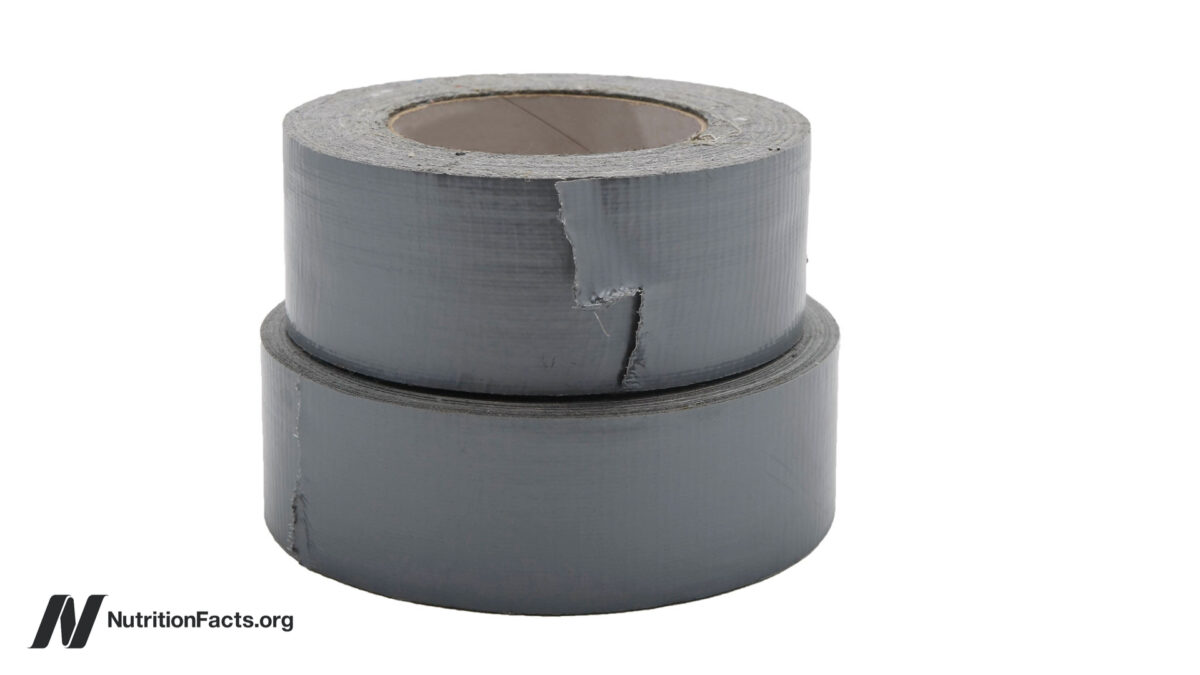Why do some experiments show that duct tape is ineffective for treating warts?
In 1978, a new approach for the treatment of warts was described, complete with compelling before-and-after pictures, as you can see below and at 0:13 in my video Which Type of Duct Tape Is Best for Wart Removal?. What was it? The application of adhesive tape was put to the test in a head-to-head trial of duct tape versus cryotherapy to resounding success.

Even though it was a randomized, controlled study, it wasn’t a double-blinded one. “Patients in the duct tape group were instructed to remove all tape prior to making a return clinic visit,” so the nurses measuring the wart changes wouldn’t be biased one way or the other. Cryotherapy can cause redness, skin discoloration, crusting, and blisters, though, so the nurses may have had an idea which study participant was in which group, which may have biased them.
So, ideally, there would be a double-blind, randomized, controlled trial, and here we go. Researchers disguised the duct tape so no one knew which study subject was in which group. Transparent duct tape was applied to the underside of moleskin, an opaque adhesive pad, and the control group got the moleskin without the duct tape. On the outside, both treatments looked the same, but half of the warts were exposed to duct tape and the other half were not. So, if there was something special about the duct tape adhesive, the duct tape group would triumph and the moleskin-only group would fail. If there was nothing special about duct tape and the remarkable success of that other study was simply due to covering warts with something sticky, then both groups would triumph. Instead, they both failed. Neither one did any better than placebo.
The first double-blind, placebo-controlled trial investigating duct tape for the treatment of warts failed—in adults. Was that the problem? The subjects in the original duct tape study were mostly children, average age of 9, whereas in this study, the average age was 54. Warts in younger populations may be more amenable to treatment, so is it possible the reason duct tape worked in the first study but not the second, is that duct tape only works on kids and not adults? To determine that, you’d have to repeat the same kind of study with children as the subjects.
Researchers randomized about a hundred schoolchildren to either duct tape applied to the wart or a corn pad placed around the wart as a placebo. Each group did something, but only one group had duct tape on their warts. In this case, the researchers used that same transparent duct tape so it wouldn’t be recognized. The result? After six weeks, the duct tape failed. “In this 6-week study, duct tape was no more effective than placebo.”
And that’s where the medical community left it. If you look at recent reviews on whether it’s better to burn warts, freeze them, or duct tape them, duct tape is dismissed as being totally ineffective, which is totally understandable. No matter how good some original results are, if you duplicate the test in a bigger, better study and can’t replicate the results, then you have to assume the first study was just a fluke.
But, did the researchers put the same thing to the test? Maybe adults weren’t the critical factor here. Maybe it was the transparent tape. In fact, “clear duct tape is not duct tape.” It turns out that “clear duct tape and moleskin both contain an acrylic-based adhesive, whereas standard silver duct tape contains a rubber-based adhesive,” which is totally different. “It is likely that the success of traditional duct tape is associated with the rubber-based adhesive that comes in direct contact with the wart during treatment.” After the two clear tape studies came out, it appears there is something unique in duct tape beyond just merely covering up a wart. And indeed, the latest addition to the body of evidence found that using actual duct tape was 80 percent effective versus cryotherapy’s 60 percent effectiveness. However, in this case, superglue was used so the duct tape would stick better.
In conclusion, “odd as it may sound, duct tape is a legitimate and often effective treatment for common warts.”
Don’t you love it when there are cheap, safe, side-effect-free solutions to common medical problems? One of the reasons I started NutritionFacts.org was to unearth all of the amazing medical knowledge that may languish in the scientific literature because there isn’t a hefty corporate budget driving its promotion. Everything we do here is free. No ads, no corporate sponsorships, no selling you anything. If you’d like to support our nonprofit work and help expand our team of researchers, please consider donating here.
This video was the conclusion to a three-part series on duct tape and warts. If the missed the first two, see Duct Tape and Wart Removal and Can You Really Remove Warts with Duct Tape?.
